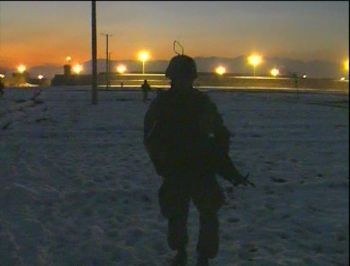
Publisher:
Bonnie King
CONTACT:
Newsroom@Salem-news.com
Advertising:
Adsales@Salem-news.com

~Truth~
~Justice~
~Peace~
TJP
Mar-26-2012 21:24

 TweetFollow @OregonNews
TweetFollow @OregonNews
Time for US Army to Police Itself: Beneath the Surface of the Kandahar Massacre
Ann Marlowe Special to Salem-News.comRegardless of the explanation, the Army’s senior leaders need to take ownership of the problem of toxic command climates—and fix the problems.
 U.S. soldier on night patrol in Afghanistan Salem-News.com photo by Tim King |
(WASHINGTON DC) - There are some easy explanations for the killings of Afghan civilians by Staff Sergeant Robert Bales in the 3rd Stryker Brigade. They describe an unbalanced individual reaching the breaking point in a stressful environment. Yes, the 38-year-old shooter from Joint Base Lewis-McChord had too many deployments in Iraq in a short period, and a traumatic brain injury (we don’t know how serious), and rumored marital trouble can’t have helped. But there are tens of thousands of soldiers who have had multiple deployments and many of these have had personal issues. They haven’t murdered any civilians.
And there is a more demanding way of looking at the tragedy, which the military itself is more prone to use. That is to focus on what the military calls “command climate” issues. Every unit has a “command climate,” just as every corporation has a culture. And while most are healthy, some are as dangerous as those at corporations like Enron or Lehman Brothers. Their commanders set a tone of aggression and contempt for civilians in Iraq or Afghanistan that permeates the ranks. Bales is said to have written to a friend on Facebook, “Giving money to Hagji [sic] instead of bullets just don’t seem right.”
This has unfortunate echoes of the attitude of the 5th Stryker Brigade Combat Team—now renamed the 2nd Stryker Brigade—home of the notorious “kill team” that murdered and maimed Afghan civilians for sport. The Strykers shot three Afghan civilians and took body parts as trophies. Twelve enlisted men and noncoms from Lewis-McChord were court-martialed and 11 convicted and sentenced—but none of the officers who set the tone were punished. The platoon’s lieutenant was actually promoted to captain.
Harry Tunnell, the colonel under whose command the Stryker “kill team” operated in 2010, is still in the Army. Tunnell was an old school body-count oriented commander who told his troops that then General McChrystal’s counterinsurgency guidelines for troops were just a suggestion. In fact, they were an order. While Tunnell may be right that Petraeus-style COIN doesn’t work, it’s hard to argue that the “kill team” approach achieved anything beyond antagonizing the Afghan population and besmirching the American name.
Tunnell’s superior, Brigadier General Frederick Hodges, told the Daily Mail, “I should have specifically told him that MG Carter [the British head of NATO’s southern command] and I had lost confidence in his ability to command from his failure to follow instructions and intent.”
But the American command let Tunnell and all the officers involved off the hook.
If the Army had been acting according to its own standards, it should have done the exact opposite, tracing the cultural problems upward, to senior leadership at the Strykers’ headquarters at Fort Lewis, Washington—which has reportedly been afflicted over a sustained period by issues including prostitution, drug dealing, and murder, in addition to an elevated suicide rate. One former commander of Lewis-McChord, the retired three-star general James Dubik, recently said of the suicides and disciplinary issues at the base, “These are major incidents and they are indicative of some kind of serious problem that exists on [base].”
One explanation is a span of control problem: Joint Base Lewis-McChord, home to 40,000 warriors, has several times the number of brigades on post as most other large bases. And unlike those, it does not have a divisional headquarters. In addition to the commanding two-star general, and two one-star deputies, a divisional HQ has the hundreds of officers that deal with administrative issues. A significant number of brigade commanders have gotten themselves into trouble when they do not have mentors on hand.
Regardless of the explanation, the Army’s senior leaders need to take ownership of the problem of toxic command climates—and fix the problems. The Army is hierarchical in the extreme, but while one aspect of this is the required obedience to orders, another is the absolute responsibility of senior leaders for what goes on in their command.
In this case, the leader is Lieutenant General Curtis Scaparrotti, who has commanded the Strykers in I Corps at Lewis-McChord from October 2010 onward. Since July 2011 he has also led NATO’S International Security Assistance Force joint command in Afghanistan and is the deputy commander of US troops there under General John Allen. Scaparrotti held these positions while the Marines urinated on Taliban corpses, Korans were burned by mistake, and Staff Sergeant Bales went on his killing spree.
Has Scaparrotti taken responsibility as a senior leader for what has gone wrong on his watch? Quite the contrary.
Special thanks to World Affairs Journal
Articles for March 25, 2012 | Articles for March 26, 2012 | Articles for March 27, 2012


Salem-News.com:
Quick Links
DINING
Willamette UniversityGoudy Commons Cafe
Dine on the Queen
Willamette Queen Sternwheeler
MUST SEE SALEM
Oregon Capitol ToursCapitol History Gateway
Willamette River Ride
Willamette Queen Sternwheeler
Historic Home Tours:
Deepwood Museum
The Bush House
Gaiety Hollow Garden
AUCTIONS - APPRAISALS
Auction Masters & AppraisalsCONSTRUCTION SERVICES
Roofing and ContractingSheridan, Ore.
ONLINE SHOPPING
Special Occasion DressesAdvertise with Salem-News
Contact:AdSales@Salem-News.com


Terms of Service | Privacy Policy
All comments and messages are approved by people and self promotional links or unacceptable comments are denied.
[Return to Top]
©2025 Salem-News.com. All opinions expressed in this article are those of the author and do not necessarily reflect those of Salem-News.com.